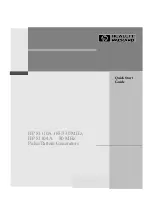
Page 8
60706-133
8290-01
Proceed as follows:
1. Remove control box cover. Vacuum or blow dust or de-
bris from the control box. Inspect all wiring for correct
routing, fraying insulation, and secure connections.
2. Remove end cover. Vacuum or blow dust and debris from
the inside of the generator. Inspect wiring for loose con-
nections, fraying insulation and correct wire routing.
3. Replace end cover and control box cover.
GENERATOR STORAGE
Before storing the generator, apply a heavy coat of grease to
the splined input shaft. Store the generator in a sheltered
area, where it is protected against snow, rain, and excessive
dust.
Generator Maintenance and Testing
A. Brushes
Under ordinary circumstances, brushes will operate for
extremely long periods without requiring replacement. They
should be inspected after the first 500 hours of operation,
and after every 200 hours of operation thereafter. Remove
brushes one at a time and check for length; be sure that each
moves freely in the brush holder. Brushes should be
replaced when worn down to 3/8”. Replace brushes in
complete sets, never singly. When replacing brushes, be
careful to reconnect the lead wires properly.
Poor contact (or “skipping”) between brush and slip ring is
caused by oil and grit, flint, or other hard substance on the
brush, or by the brush not being properly shaped to fit the slip
rings. Remedy these defects by fitting the brushes to the
slip-ring curvature. Place # 00 sandpaper under the brushes
with the abrasive side to the brushes, and work it back and
forth until the brushes are the same shape as the slip-rings.
B. Slip rings
The four continuous copper rings located on the end of
the armature are the generator output slip rings. For
proper generator output, the surface of the slip rings must
have a smooth, shiny, highly polished finish. Normal
brush seating will transfer a shiny black finish that will
seat the copper surface. This finish should not be
removed unless it becomes dull or begins to build up.
Under sustained use, it is advisable to check and if
necessary, polish the ring surfaces with a crocus cloth to
maintain the smooth finish.
C.
Electrical Testing
Testing generator fields for opens and grounds.
1. Disconnect field leads from rectifier.
2. Set multimeter to read resistance, and connect the meter
leads to the field leads. If field is open, meter will read
infinite resistance (very high ohms). Repair or replace
field if it is open. Typical resistance for these fields vary
from 20.2 TO 22.4 ohms.
3. Leaving one meter lead connected to the field, connect the
other meter lead to the field shell. If meter indicates
continuity, any reading other than infinite resistance, the
field is grounded and should be repaired or replaced. To
determine which of the fields is grounded, cut the connec-
tor between the two coils and retest to determine which
coil has the low resistance path.
Testing the Armature for Opens and Grounds
1. Remove all brushes.
2. Ground fault test - set multimeter to read high resistance
(meg-ohms).Holding one meter lead against a clean spot
on the armature shaft, touch the other lead to each of the
slip rings (one at a time) while observing the meter. If
meter indicates continuity (any reading lower than one
meg-ohm), the armature is grounded. Dirt between the
slip rings and on the insulator surface can cause ground-
ing. If grounding was indicated, carefully clean all dirt off
the slip rings and their insulators and then recheck it. Re-
place the armature if it is grounded and unrepairable.






























